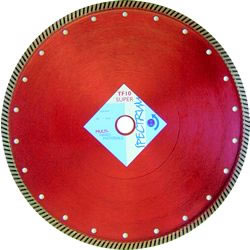Account
We offer FREE UK Mainland delivery for orders over £50! (EX VAT exclusions apply).
We offer FREE UK Mainland delivery for orders over £50! (EX VAT exclusions apply).

Quote Ref: @5315
Product ID: SPEC_TF10SUPER_300
Manufacturer: Spectrum
Price: (£53.00 ex VAT) £63.60 (inc VAT)
63.60 2026-02-02Brand: Spectrum
Identifier: SPEC TF10SUPER 300
Published on Wed 22nd May 2013 by D Courtney
There are many different types of diamond cutting / drilling tools, such as circular blades, drills and grinding wheels, with each tool having it's own unique uses. They all however keep the same basic principles:
A diamond-impregnated segment may have three different forms, a segmented rim, a continuous rim or a castellated rim.
The metal centre of the segmented blade is produced from very high quality quenched, drawn steel, with the segments separated by slots. These slots assist in cooling the blade during sawing by allowing water (wet cutting) or air (dry cutting) to flow between the segments. They also permit a certain amount of elasticity in the blade during sawing.
Most of the steel sheet is mill-tensioned so that the blade rotates vertically straight whilst allowing it a certain elasticity.
The segments or diamond-impregnated rims are a mixture of diamond grains and powdered metal. The diamonds used in the manufacture of the saw blades are almost exclusively industrial diamonds of different sizes and qualities depending on the material to be cut. During the manufacturing process the metallic powder and diamond grain mixture is compressed at very high temperature to obtain a solid metal alloy (called the bond or matrix) which retains the diamond grain.
The segment or rim is slightly wider than the steel centre of the blade. This clearance enables the leading edge to penetrate the material without engaging the steel.
Various processes are used for fixing the segments or rims firmly to the steel:
A diamond saw blade does not cut but works by milling. When the tool is given its edge in the factory, the individual diamond crystals are exposed on the leading edge and the sides of the segment or rim. It is these exposed diamonds which carry out the milling.
The metal matrix holds each diamond in place. Whilst working, each diamond is shouldered at the back by a "comet's tail" which reinforces the supporting action of the bond.
Whilst the blade is rotating on the saw shaft, the operator pushes the blade into the material. The surface diamonds thus exposed mill a groove in the material, reducing it to fine powder. Whilst the blade mills the material, the latter exerts wear on the blade.
During cutting the exposed diamonds may crack or break (all the more rapidly, the harder and denser the material). The material simultaneously starts to abrade the metal matrix, which gradually releases more diamonds. The more abrasive the material, the more rapid the tendency to wear down the matrix.
With a diamond tool properly matched to the material being cut, the equilibrium between the work of the diamond and the resistance of the bond to abrasion is at its optimum: the diamond is held in place until it is destroyed and new crystals appear. The whole quality of a diamond tool resides in this equilibrium.
Blades intended for cutting hard, dense less abrasive materials (such as tiling, hard bricks, stone or old hard concrete), require a softer metal matrix. This will wear down faster, replacing the worn diamonds fairly quickly so that the blade continues to cut.
Blades intended for cutting soft, abrasive materials (like green concrete and asphalt) must have a hard, abrasion-resistant metal matrix in order to retain the diamonds for a greater length of time.
Published on Wed 22nd May 2013 by D Courtney
Brand new packaged items only.
Comes with a full manufacturer warranty (not including consumable products).
Please make use of any product reviews or youtube clips we have available to learn more about the item.
This item is usually delivered within 2 working day(s).
SSL Certified Secure website to ensure secure online ordering.
Please return the item/s if not suitable for a full refund (within 7 working days of receipt).
We guarantee security of all your personal details, we do not pass on any customer information.
Accept all payment methods including all major Credit Cards, Paypal and Amazon Payments.
Order online now using our Secure SSL Certified Secure website.
Add this product to your basket and come back at any time to complete the order.
Order by phone on 01737783101.
Order with an official purchase order by emailing [email protected]. We will check your account status or if you do not hold an account we will credit check your organisation, confirm and process your order. Please note the first order(s) will always need to be paid upfront unless you are a government linked organisation. Goods remain the property of Sitebox Ltd until paid for in full as per our full terms and conditions.


